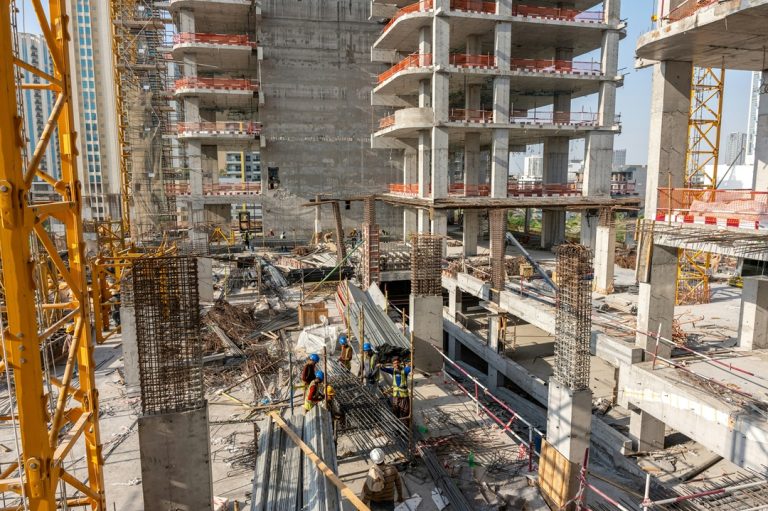As Dubai continues to grow and densify, the conversation around aircraft noise remains relevant, particularly with Dubai International Airport (DXB) operating at full capacity until its planned transition to Dubai South (Al Maktoum) in 2032.
While much attention is rightly focused on the city’s future transport infrastructure, the question facing developers, planners, and consultants today is more immediate:
Does aircraft noise still carry meaningful design and commercial risk in the present day?
In many cases, the answer is yes. And not just in terms of compliance, but in terms of occupant health, long-term asset value, and resident satisfaction.
🔍 Real Data: Noise Exposure Near DXB
We recently carried out an environmetnal noise survey near the DXB flight corridor, approximately 1.2 km laterally offset from the direct DXB departure path from runway 30R.
Here’s a summary of the 24 hour noise levels, calculated from Sound Exposure Levels (SEL) based on site measured noise, isolating aircraft movements:
| Period | Aircraft Noise (LAeq) |
|---|---|
| LDay (07:00–19:00) | 51 dBA |
| LEvening (19:00–23:00) | 50 dBA |
| LNight (23:00–07:00) | 49 dBA |
| LDEN (24hr weighted) | 50 dBA |
⚠️ It’s important to note that the measurement location was not directly under the flight path, so noise levels at developments situated directly beneath departure routes are likely to be considerably higher.
For example a study in 2023 [1] recorded noise levels within residential buildings near the flight path of up to NC 47 (approximately 52 dB LAeq) during aircraft movements, with windows closed.
Noise prediction tools such as https://noise-map.com/ are useful for high-level, indicative concepts of noise levels, however our recent survey shows variance of approximately 9dB from the site-measured values in the same location. When it comes down to planning and design decisions, this difference is significant.
🧠 Health and Commercial Implications: What the Data Tells Us
While Dubai isn’t goverened by EU legislation, the European Environmental Noise Directive (END) [2] and particularly its recent technical guidance updates, remains one of the most widely recognised global frameworks for assessing environmental noise exposure. Coupled with WHO environmental noise guidelines [3], this offers useful perspective:
Health
The END’s latest updates provide clearer interpretation of 24 hour noise exposure (LDEN) and night noise exposure (LNight) thresholds.
| LDEN / LNight | Indicative Effect Description |
|---|---|
| 50–54 dB / 40–44 dB | Noticeable, but generally not intrusive in urban areas |
| 55–59 dB / 45–49 dB | Intrusive, even in typical city environments |
| 60–64 dB / 50–54 dB | High noise exposure, serious disruption to outdoor amenity |
| 65–69 dB / 55–59 dB | High annoyance likely, even indoors with open windows |
| >70 dB / >60 dB | Strong potential for health impacts and sleep disturbance |
The END also now emphasises more transparent public disclosure of noise exposure data, and encourages greater consideration of long-term health effects, including stress, cardiovascular impacts, and sleep disruption.
Commercial Value
Beyond health, noise exposure also has clear market implications. According to the EEA Technical Report No. 11/2010 [4]:
“Properties exposed to higher noise levels will have a lower value… The best estimate is that house prices lose 0.5% of their value per decibel over 50–55 Lden. The range of research results is between 0.2% and 1.5%, with a tendency for higher values for aircraft noise.”
This relationship between noise exposure and real estate value is supported by decades of studies and is particularly relevant in lifestyle-led markets like Dubai.
While this might not trigger mandatory mitigation under local standards, buyer perception doesn’t follow standards. If residents can hear it, it becomes your problem, whether legally or reputationally.
📆 But DXB Is Moving… So Why Bother?
Fair point, but the closure of DXB is not imminent. Here’s what developers need to keep in mind:
-
DXB still averages over 600 departures daily, including 179 during night hours [5]
-
Aircraft noise will remain relevant for the next 5–7 years, minimum
-
Residents won’t care that noise might reduce eventually, they’ll care about their living experience now
On top of that, once DXB is gone, new noise sources (roads, rail, infrastructure) will take its place in many areas. Your acoustic risk doesn’t disappear, it just changes.
🎯 A Practical Acoustic Strategy
At Focus Acoustics, we work with project teams to bring clarity to environmental noise exposure, helping you understand, manage, and respond to risks through clear, practical advice:
✅ Measured evidence, not generic modelling
✅ Noise exposure summaries across day evening and night-time periods, and defined by noise source type
✅ Advice that’s rooted in both health impact and commercial risk
✅ Sensible mitigation guidance that balances cost, buildability, and future risk
We’re here to reduce risk, simplify complexity, and help you close your project on time, on scope, with clarity.
🚀 What You Should Do Next
Aircraft (or other environmental noise – road, rail, industry) might not be a headline issue on every site, but where exposure is present, it’s worth understanding clearly. Whether for compliance, resident comfort, or long-term investment value, environmental noise is one of those factors that’s often underestimated… until it becomes a problem.
If you’d like to take a closer look at your site’s acoustic profile, or you simply want to sense-check your exposure assumptions → Get in touch to start the conversation.
Let’s keep your team focused on what matters and make sure noise isn’t the thing that breaks your silence post-handover.
References:
- Naglaa Sami Abdelaziz Mahmoud, Chuloh Jung, Nahla Al Qassimi, Evaluating the aircraft noise level and acoustic performance of the buildings in the vicinity of Dubai International Airport,
Ain Shams Engineering Journal, Volume 14, Issue 8, 2023. https://www.sciencedirect.com/science/article/pii/S2090447922003434 - European Commission. Directive 2002/49/EC of the European Parliament and of the Council of 25 June 2002 relating to the assessment and management of environmental noise – Declaration by the Commission in the Conciliation Committee on the Directive relating to the assessment and management of environmental noise. https://environment.ec.europa.eu/topics/noise/environmental-noise-directive_en
- World Health Organization (WHO) – Environmental Noise Guidelines for the European Region https://www.who.int/europe/publications/i/item/9789289053563
- European Environment Agency (EEA) Technical report No 11/2010 Good practice guide on noise exposure and potential health effects
- Based on 3 day average scheduled & confirmed flight counts from https://www.flightradar24.com/airport/dxb






